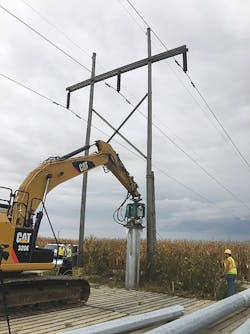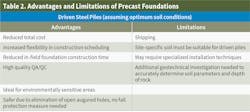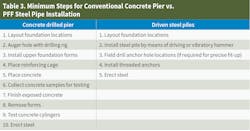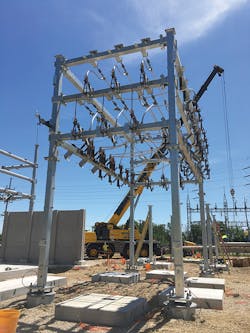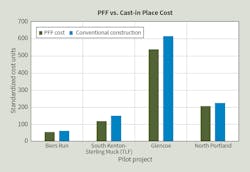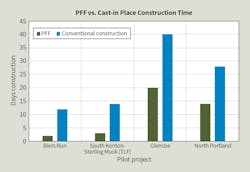Flexibility With Prefabricated Foundations
A progressing transmission construction boom has notably affected the availability of qualified construction personnel and equipment, along with other resources for transmission construction projects. One solution to the limited outages and resources for foundation construction is the use of prefabricated foundations (PFFs). The most common existing applications of PFFs focus on the support of transmission line structures, primarily in grillages and direct embed foundations.
In 2017, American Electric Power (AEP) conducted three pilot projects that utilized PFF designs for station and transmission line projects. Over the course of these pilot projects, the AEP team observed and documented significant improvements that reduced the cost of foundation construction, minimized construction schedules, and improved field worker safety. PFFs provide varying and circumstantial advantages over conventional cast-in-place foundations – when optimal site-specific soil conditions are present for the support of station and transmission line structures.
The PFFs serve the same purpose as traditional foundations; however, PFFs are manufactured at an off-site facility, and then shipped to a project-specific location for installation. Onsite, PFFs are installed by various means: driving, vibration, torque, excavation, and backfill. PFFs are manufactured using different materials and styles. Concrete, steel, and wood are common materials used for manufacturing PFFs, and common types of PFFs include driven piles, grillages, helical piles, precast concrete slabs, and spread footings.
Using Proven Technology in A New Area
PFFs have a vast history and are utilized in a diverse fashion in the construction industry. PFFs are by no means a newly developed technology. However, PFF implementation within the electric transmission industry has been limited, and primarily focused on the support of transmission line structures. Steel grillages and direct embedded steel foundations are the most prominent types of PFF currently used to support transmission line structures. The pilot projects used in the study focus solely on the use of precast concrete foundations and driven steel piles.
In order to successfully implement these pilot projects, the team investigated and documented the advantages and limitations of PFFs. Precast foundations are concrete foundations cast in reusable forms – using high early-strength concrete at a manufacturing facility. After manufacturing, precast foundations are shipped to the construction site, where they are lifted and placed on-grade or in open excavations.
The PFF present an opportunity to batch, test, and place concrete within a single location under a controlled environment. This process eliminates the logistics of concrete transportation, performing in-field concrete tests, collecting concrete test cylinders, and controlling onsite concrete curing. In addition, the ease of assembling forms, tying rebar, and placing anchor bolts within a controlled environment all contribute to increased quality assurance and quality control.
The advanced QA/QC processes associated with precast foundation manufacturing can lead to extended structure life expectancy and increased reliability. Advantages and limitations of precast concrete and driven steel pile foundations vary significantly. AEP investigated the advantages and limitations for both types of PFF. Findings are summarized in Tables 1 and 2. Two key areas were identified for quantifying the impact of PFFs on the proposed pilot projects.
The first focuses on reducing the total cost associated with foundation construction. The second focuses on minimizing the length of the construction schedule for foundation installation. Driven steel pile foundations are constructed in a steel fabrication shop and are commonly manufactured using H-pile, pipe, tubular, and welded plate sections. Steel pile foundations can be driven into in-situ soil (excluding profiles with large cobbles or soil rock) by means of impact driving or vibratory hammer.
In addition to reducing environmental impacts and installation efforts, above-grade structures can be immediately erected to eliminate the time lapse between concrete placement, curing, and testing. For short outage windows, this allows an optimum amount of work to commence with little to no downtime. Table 3 provides a simplified overview of the differences between the installations of PFF steel piles vs. traditional cast-in-place concrete pier foundations.
Pilot Projects
In 2017, three transmission projects were identified as advantageous for piloting PFFs. These projects were selected based on the project needs, the required foundation sizes, and appropriate site-specific soil conditions.
Two of the pilot projects were station projects, and one was for a transmission line project. A summary of the project scope and identified PFF solutions are provided in Table 4.
Biers Run Station Pilot
The Biers Run Station brownfield PFF pilot project was implemented to support the installation and future deployment of stored control houses. PFF steel piles were selected to support the control buildings. The steel piles were designed to be installed with use of a vibratory hammer to cut through dense clay soils. The installation of the 22 steel pile foundations only took a total of 12 hours to complete over a two-day period. During this time, the crew experienced light to heavy rain conditions.
The PFF installation schedule was not impacted by the poor weather. If concrete had been used instead, the concrete placement would likely have been canceled and delayed by several days. The foundations were inspected after installation to verify location, plumbness, and elevation tolerances. Shortly after installation of the foundation and post-installation assessment, the control buildings were installed and anchored.
South Kenton – Sterling Transmission Line Pilot
The South Kenton – Sterling transmission line structure rehabilitation project was identified as a PFF pilot project, due to site geotechnical concerns with a high water table and soft soils, and the potential for instable soil conditions during excavation. Steel pile PFFs were selected for this project – to mitigate the cumbersome drilling means and methods, and minimize the environmental impact of the project through the elimination of drilling spoils.
An additional advantage of using PFFs for this project was the ability to meet the accelerated construction schedule due to a reduced outage window. Fifteen PFF steel piles were used to support the replacement of six H-frame structures and one running corner structure.
Prior to foundation construction, the line outage was canceled, and rescheduled approximately four weeks later. Typically, this change would cause a number of construction scheduling issues for the drilling crew, concrete procurement, and concrete testing agency. PFFs minimized the impact to the schedules and affected parties. The PFF delivery date and equipment rentals were easily shifted to accommodate the new schedule.
Glencoe Station Pilot
The Glencoe Station greenfield pilot project was selected to accelerate the foundation construction schedule and to eliminate the extent of cold weather concreting that would be needed onsite. Based on the recommendations of the geotechnical report and the Ohio Department of Natural Resources, combined foundations, spread footings, and slabs were designed to support all structures and equipment for this project, in order to limit drilling that could approach an underground mine. Precast foundations were identified as an equivalent to the cast-in-place foundations.
The data collected during all three pilot projects indicated a reduction in the foundation construction costs, and a reduction in foundation installation duration. When construction material and installation costs are compared to internal estimates, the comparison indicated that the use of PFFs resulted in a 10% to 20% reduction in the foundation installation costs for these site conditions. PFFs also reduced the foundation construction time by 50% to 80%. PFFs positively affected the project costs and timeline and led to project success.
What’s Next
The initial data points provided by the pilot projects clearly indicate advantages for the use of PFFs for transmission construction projects. A summary of the pilot project data is presented in Chart 1 and Chart 2. In addition to planned projects, AEP is working with field services on developing PFF programs for quick-turnaround projects, such as replacement after equipment failures, and grid restoration efforts. Use of PFFs will reduce outage durations – and more efficiently – restore grid reliability.
PFF implementation can result in a reduction to the foundation construction timeframe of 50% to 80%, when compared to the timeframe required for traditional cast-in-place concrete foundations. PFFs provide additional varying and circumstantial advantages over conventional cast-in-place foundations, ranging from improved QA/QC to minimizing installation environmental impacts. PFFs are an advantageous alternative to conventional foundations that can be strategically deployed to support structures for transmission station and line projects.
About the Author
Aaron P. Darby
senior engineer
Aaron P. Darby, P.E., is a senior engineer in the Transmission Line Standards Department at American Electric Power. He has more than seven years of transmission engineering experience at American Electric Power. The past five years he has focused on structural and foundation standards development which includes the modeling, design, testing, and reinforcing of transmission structures. Darby received his BSCE from Virginia Tech, with an emphasis in Structural Engineering, and is a Professional Engineer in Virginia. Aaron is a member of ASCE.
Olivialin A. Miller
Olivialin A. Miller, P.E., is a supervisor in the Transmission Line Standards Department at American Electric Power. She has more than 11 years of experience with AEP, including previous responsibilities as Station Standards Supervisor. Olivia received her BSCE from The Ohio State University and is a Professional Engineer in Ohio.
Daniel S. Cuffman
Daniel S. Cuffman, P.E., is a planning and engineering supervisor in the Station Engineering Department at American Electric Power. He has more than eight years of structural engineering experience split between the fields of transmission utilities and telecommunications. His experience has been primarily concentrated in the areas of structural steel and reinforced concrete design. Cuffman received his BSCE from the University of Cincinnati, with a focus in Structural Engineering. He is also a Professional Engineer in the state of Ohio.

